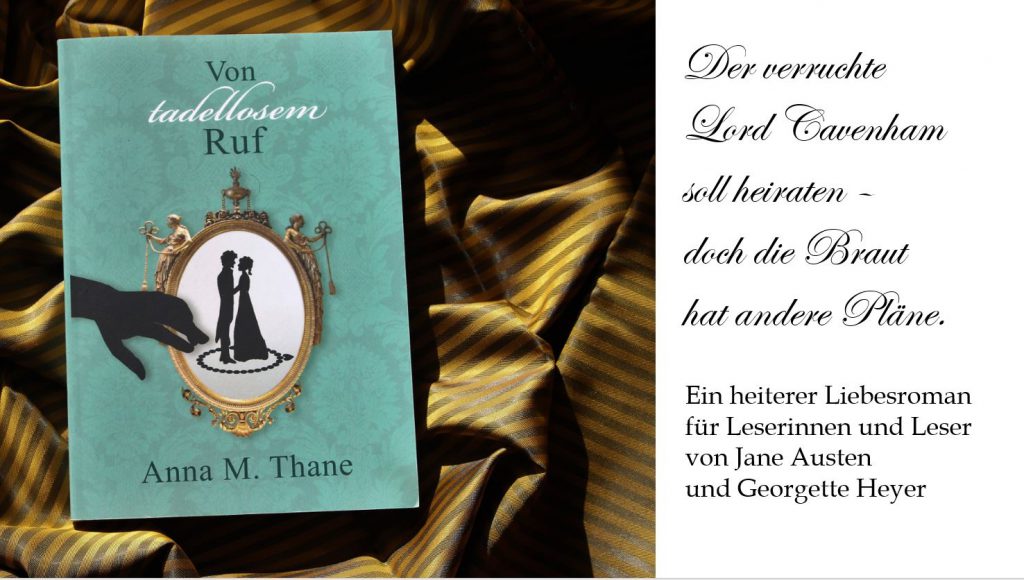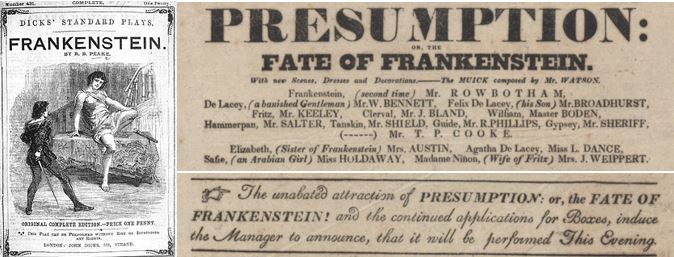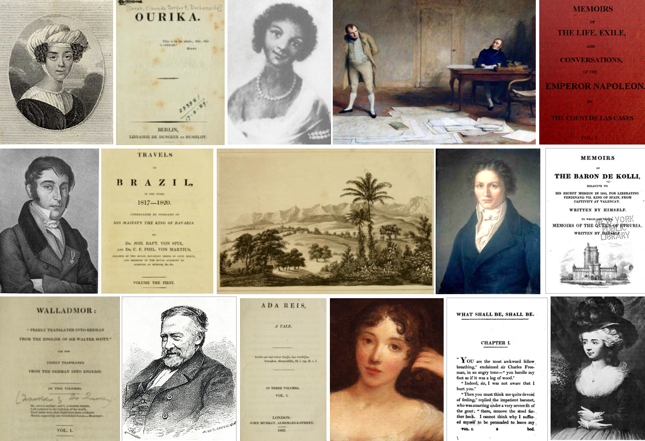
Eight years after the Napoleonic Wars, the economy gets back on track. Science and technology advance significantly. Politicians are discussing reforms, and some repressive laws have already been repealed. All the while, high society sticks to the ‘old’ ideas and rules.
The book market is a mirror of this situation: the fiction genre mainly celebrates the familiar authors, but at the same time it starts to open towards more ‘radical’ topics.
In non-fiction, new publications highlight the path to the future, or look back to the ‘good old times’ of everyone’s favourite enemy: Napoleon.
Check out my list of popular fiction and non-fiction releases. I have added links to online versions of each book, so you can actually read like its 1823!
15 novels to enjoy in 1823
1. Enjoy a literary hoax
Walladmor by Willibald Alexis
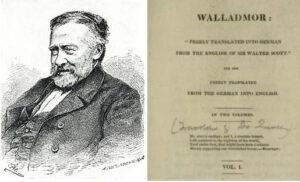 More than one thing about Willibald Alexis is not as it seems to be. First, the name is a pseudonym. Second – and of more important: He claims that the novel “Walladmor” he has published is a free translation from a so far unknown story by the Great Walter Scott. “Walladmor” is nothing like that. It is Willibald Alexis’ own work. However, it is so good and so convincing “a Walter Scott” that the novel is an immediate success. It is translated into several languages, including English. Only when the third and final volume is published, the hoax becomes obvious.
More than one thing about Willibald Alexis is not as it seems to be. First, the name is a pseudonym. Second – and of more important: He claims that the novel “Walladmor” he has published is a free translation from a so far unknown story by the Great Walter Scott. “Walladmor” is nothing like that. It is Willibald Alexis’ own work. However, it is so good and so convincing “a Walter Scott” that the novel is an immediate success. It is translated into several languages, including English. Only when the third and final volume is published, the hoax becomes obvious.
Read an English translation here: https://archive.org/details/walladmor01dequ
Walter Scott responds to “Walladmor” in his introduction to “The Betrothed”, and thus acknowledges his awareness of William Alexis’ (aka Georg Wilhelm Heinrich Häring) literary hoax.
2. Beware the perils!
The Three Perils of Woman by James Hogg
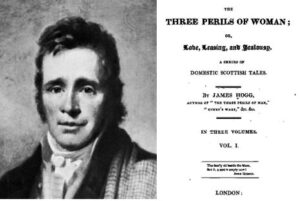 The three perils are love, leasing* and jealousy, as heroines Gatty Bell and Sally Niven each have to find out:
The three perils are love, leasing* and jealousy, as heroines Gatty Bell and Sally Niven each have to find out:
Sheep farmer’s daughter Gatty falls in love with a Highland aristocrat – and he with her. But somehow each comes to believe that the other detests them.
Attractive and virtuous Sally is in love with the local smith, Peter. Alas, Peter kills a man! Sally tries to save him by concocting a net of lies. The story gets more complicated when each of them gets married to someone else, and then, by misinterpreting and misunderstanding, Jealousy takes over.
Read it online here: https://archive.org/details/threeperilswoma03hogggoog/page/n8/mode/2up
(*leasing is an old Scottish term for lying)
3. Stand up against the despot
Valperga: or, the Life and Adventures of Castruccio, Prince of Lucca by Mary Shelley
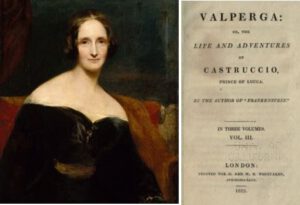 Despot Castruccio Castracani threatens the fortress of Valperga, governed by Countess Euthanasia. Castruccio is in love with Euthanasia, but he is not very good in showing it: He forces Euthanasia to choose between her feelings for him and political liberty…
Despot Castruccio Castracani threatens the fortress of Valperga, governed by Countess Euthanasia. Castruccio is in love with Euthanasia, but he is not very good in showing it: He forces Euthanasia to choose between her feelings for him and political liberty…
Mary Shelley addresses questions of political power and moral principles. She creates a feminist version of Walter Scott’s masculine genre, the historical novel. Critics in 1823 misinterpret Valperga as a love story.
Read it online: https://archive.org/details/valpergaorlifead03shelrich/page/n7/mode/2up
4.-6. Get 3 novels by Walter Scott for the price of …well, 4
“Saint Ronan’s Well”, “Quentin Durward”, and “Peveril of the Peak” by Walter Scott
Sir Walter Scott is very active this year: three of his novels hit the book market:
Saint Ronan’s Well is the only novel Scott wrote with a modern (aka 19th-century) setting and with a fashionable spa in the Scottish Borders as location. The plot is very classic: Two men rival for the same woman. Rumour has it that the heroine’s story is influenced by a true legal case involving a Border family.
Read it online here: https://archive.org/details/stronanswell00scot/page/n7/mode/2up
Quentin Durward is a Scottish archer in the service of the French King Louis XI. When Burgundian heiress Isabelle is about to be forced into an unwanted marriage with a bandit-captain, Quentin, initially a bodyguard for her on her trip to the groom-to-be, prevents all evil plans and wins Isabelle’s hand. The rivalry between Louis XI of France and Charles the Bold, Duke of Burgundy, drives the plot. It offers murder, treachery and a happy ending. The novel is based on a real historical event in 1482.
Read it online here: https://archive.org/details/quentindurward01scotuoft/page/n7/mode/2up
Peveril of the Peak is the longest novel Walter Scott has ever written, and you have to invest some extra shillings to buy it (it’s £2 2s instead of the usual £1 11s). The plot may be worth it: Julian Peveril, a Cavalier, is in love with Alice Bridgenorth, a Roundhead’s daughter. Unfortunately, both Julian and his father are accused of involvement with the “Popish Plot” of 1678. They are arrested and imprisoned in the Tower of London. It takes the help of Fenella, an illegitimate daughter of Bridgenorth’s brother-in-law and a Muslim woman, to help Love to triumph.
Read it online: https://archive.org/details/peverilofpeakrom01scot/page/n3/mode/2up
7. Feel for Ourika
Ourika by Claire de Duras, originally published anonymously.
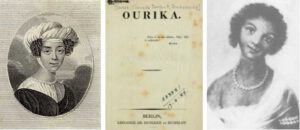 The story is loosely based on the real life of a slave girl who was purchased around 1786 by a French colonial administrator of Senegal, and given as a gift to a French family.
The story is loosely based on the real life of a slave girl who was purchased around 1786 by a French colonial administrator of Senegal, and given as a gift to a French family.
Set in the time of the French Revolution, the novella addresses topics such as nationality, exile and racism. It is one of the first books to do so, and is today considered as a first step towards modern identity politics.
The real-life Ourika inspired poems, plays and novels in 19th-century Paris, and she became the talk of literary salons. She died of an unknown illness aged only 16.
Read the novel online (in French): https://archive.org/details/ourikadu00durauoft/page/n9/mode/2up
8. Come to good fortune through false identity
What shall be, shall be by Mrs Meeke
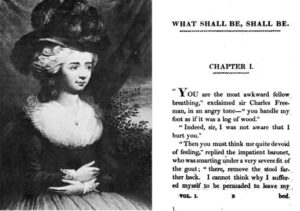 If I told you that the novel is about a young man in a low rank of life who finds out that he is the son of a duke – yes, you would guess correctly: this book is easy-reading. However, Elizabeth Meeke was the era’s foremost writer of cheap novels. She wrote about 30 books and made her living by it (she had to, as her reputation was shattered by an unfortunate marriage). At one time, she outpublished even Walter Scott. Her work is forgotten today – or is it waiting to be rediscovered?
If I told you that the novel is about a young man in a low rank of life who finds out that he is the son of a duke – yes, you would guess correctly: this book is easy-reading. However, Elizabeth Meeke was the era’s foremost writer of cheap novels. She wrote about 30 books and made her living by it (she had to, as her reputation was shattered by an unfortunate marriage). At one time, she outpublished even Walter Scott. Her work is forgotten today – or is it waiting to be rediscovered?
Give it a try and read it online here: https://play.google.com/books/reader?id=6eIR5oRRePsC&pg=GBS.PP4&hl=de
9. Explore the wounds left by war
Seventy-Six by John Neal
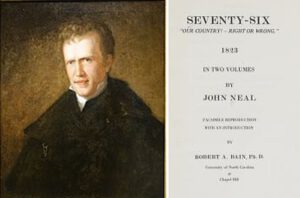 The historical novel from a rising American author tells a thrilling love-and-war story set in the American Revolutionary War.
The historical novel from a rising American author tells a thrilling love-and-war story set in the American Revolutionary War.
Twenty-something Jonathan Oadley looks back to the winter of 1776: British and Hessian raiding parties cause fear in New Jersey. He and his brother decide to act: They join the Continental Army… . Battle scenes and the progress of war interweave with a love story (the neighbour’s daughters Clara and Lucia are the love interests of the brothers). Violent acts committed in war and in duel lead to pain and self-loathing.
Read it online here: https://archive.org/details/seventysixourcou0000neal/page/n3/mode/2up
10. Watch a literary star being born
Han d’Islande by Victor Hugo
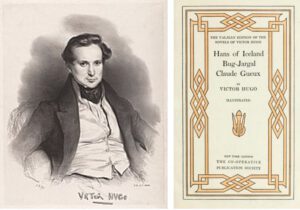 A certain Victor Hugo publishes his first novel. Like many young writers of his generation, he is deeply influenced by Chateaubriand, the shining star of Romanticism. Han d’ Islande is set in Norway, and it features a murderous human monster, a hero in love with a destitute heroine, court-intrigues and uprisings, dungeons and dark towers. If your French is not up to reading a whole novel, you will have to wait for the translation into English for two more years or…
A certain Victor Hugo publishes his first novel. Like many young writers of his generation, he is deeply influenced by Chateaubriand, the shining star of Romanticism. Han d’ Islande is set in Norway, and it features a murderous human monster, a hero in love with a destitute heroine, court-intrigues and uprisings, dungeons and dark towers. If your French is not up to reading a whole novel, you will have to wait for the translation into English for two more years or…
…read it online here: https://archive.org/details/hansoficelandbug00hugo/page/n7/mode/2up
11. Go Frankenstein!
Presumption; or, the Fate of Frankenstein by Richard Brinsley Peake
Richard Brinsley Peake brings Frankenstein on stage! His play is based on the novel Frankenstein by Mary Shelley. It is a success, with 37 performances during its original run.
Mary Shelley attends one of the London shows. Though she thinks the story not well managed, she is quite pleased at the end: “But lo & behold! I found myself famous! — Frankenstein had prodigious success as a drama (…) I was much amused, & it appeared to excite a breathless eagerness in the audience.”
Get the script online here and start your home theatrical: https://romantic-circles.org/editions/peake/play/act1.html#act1
12. Try and make sense of a lady’s final revenge on Lord Byron
Ada Reis, A Tale by Lady Caroline Lamb
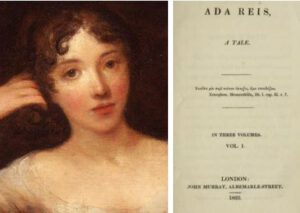 Corruption is one of the themes in Ada Reis. The novel is a mix of a fictional travel narrative, a society novel, and a romance – and it does not make an easy read. The main story is about Ada Reis, an unscrupulous but handsome adventurer who kills and betrays to satisfy greed and ambition (he is said to resemble Lord Byron, who once had been Lady Caroline’s lover). When a prophecy announces that Ada’ daughter, Fiormonda, will rule a kingdom and that his own corruptions will be allowed without question, Ada sinks deeper and deeper into moral indiscretions, tempted by the devilish Kabkarra. All the while, the villain Condulmar (also resembling Lord Byron) has his eyes on Fiormonda. He leads her into an immoral relationship … . It all ends in eternal punishment for everyone, and only Fiormonda escapes.
Corruption is one of the themes in Ada Reis. The novel is a mix of a fictional travel narrative, a society novel, and a romance – and it does not make an easy read. The main story is about Ada Reis, an unscrupulous but handsome adventurer who kills and betrays to satisfy greed and ambition (he is said to resemble Lord Byron, who once had been Lady Caroline’s lover). When a prophecy announces that Ada’ daughter, Fiormonda, will rule a kingdom and that his own corruptions will be allowed without question, Ada sinks deeper and deeper into moral indiscretions, tempted by the devilish Kabkarra. All the while, the villain Condulmar (also resembling Lord Byron) has his eyes on Fiormonda. He leads her into an immoral relationship … . It all ends in eternal punishment for everyone, and only Fiormonda escapes.
Lady Caroline took pains to have the cultural background of the novel correct: famous travellers Giovanni Battista Belzoni and William Bankes helped with the facts.
Read it online here: https://archive.org/details/adareistale01lamb
13. Love against the rule
Gretna Green Marriages: or the Nieces by Sarah Green
The novel offers a plot about a couple eschewing parental strictures and getting married in Gretna Green. However, it also depicts the impact of ‘race’ and the importance of the West Indies to the British economy in the long 18th century. The main characters include Rosa, who is expected to marry a much older man, and Pembroke, an elegant West Indian servant who proves to be Rosa’s best friend and confidant.
Sarah Green was one of the ten most prolific novelists of the early nineteenth century. Her writing borrows heavily from famous gothic novels, and her plots tend to brim over with false identities and mysterious pasts.
Buy it online here: https://www.worldcat.org/de/title/1228874987?oclcNum=1228874987
14. Discover the first American environmental novel
The Pioneers, or The Sources of the Susquehanna; a Descriptive Tale by James Fenimore Cooper.
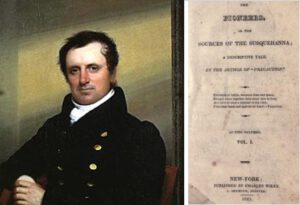 It’s 1793 at the frontier of New York. Leatherstocking Natty Bumppo embarks on a hunt for a deer. Tracking it down, he runs into Judge Marmaduke Temple, who is also out hunting. While they argue over who killed the deer and gets to claim it, they first fail to notice the collateral in their hunt: It is Oliver Edwards, a young man who has been wounded by a stray shot from Judge Temple’s gun. Finally realising the wounded young man, Leatherstocking and Judge Temple bring him into the town to care for the wound. Oliver gets better soon, but he becomes caught in the center of the reoccurring arguments between Leatherstocking and the townspeople about mass slaughter of animals. Leatherstocking attempts to sway Oliver to his side, and tries to convince the town to treat the environment with respect. Can he overcome the threat of imprisonment as well as natural tragedies?
It’s 1793 at the frontier of New York. Leatherstocking Natty Bumppo embarks on a hunt for a deer. Tracking it down, he runs into Judge Marmaduke Temple, who is also out hunting. While they argue over who killed the deer and gets to claim it, they first fail to notice the collateral in their hunt: It is Oliver Edwards, a young man who has been wounded by a stray shot from Judge Temple’s gun. Finally realising the wounded young man, Leatherstocking and Judge Temple bring him into the town to care for the wound. Oliver gets better soon, but he becomes caught in the center of the reoccurring arguments between Leatherstocking and the townspeople about mass slaughter of animals. Leatherstocking attempts to sway Oliver to his side, and tries to convince the town to treat the environment with respect. Can he overcome the threat of imprisonment as well as natural tragedies?
This is the start of the famous Leatherstocking Tales! Read it online here: https://archive.org/details/pioneersorsource01cooprich/page/n3/mode/2up
15. Witness the invention of Santa Claus
Account of a Visit from St. Nicholas by Anonymous
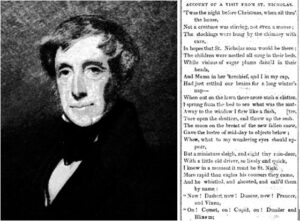 On December 23 in 1823, a certain poem is published anonymously in the Sentinel newspaper in New York. Clement Clarke Moore later claimed authorship of the poem.
On December 23 in 1823, a certain poem is published anonymously in the Sentinel newspaper in New York. Clement Clarke Moore later claimed authorship of the poem.
The plot is about the night of Christmas Eve. A family is settling down to sleep, but the father hears strange noises on the lawn outside. He takes a look and sees Santa Claus in a sleigh pulled by eight reindeer. The sleigh lands on the roof, Santa enters the house by sliding down the chimney, and…. – but you know the rest.
Have a look at the original article here: https://en.wikipedia.org/wiki/A_Visit_from_St._Nicholas#/media/File:A_Visit_From_St_Nicholas_-_Troy_Sentinel.png
7 great non-fiction books for diving into the world of 1823
Study a close-up view of Napoleon
The Memorial of Saint Helena by Emmanuel-Auguste-Dieudonné Las Cases.
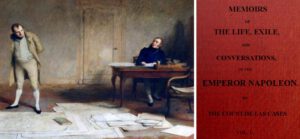 The Comte de Las Cases was a trusted follower of Napoleon. He accompanied the ex-emperor to Saint Helena and acted informally as a secretary. He took notes of their near-daily conversations about Napoleon’s life, career, political philosophy, and the conditions of his exile. He later compiled these notes into a book.
The Comte de Las Cases was a trusted follower of Napoleon. He accompanied the ex-emperor to Saint Helena and acted informally as a secretary. He took notes of their near-daily conversations about Napoleon’s life, career, political philosophy, and the conditions of his exile. He later compiled these notes into a book.
Las Cases was arrested for trying to send personal letters to Europe, and was expelled from St. Helena at the end of 1816. His manuscript of the Memorial of Saint Helena was confiscated. It was only returned to him after Napoleon’s death. Even several years after the ex-emporer’s death, the book was a success. It counted among the bestselling books in France until 1840 and was translated into English, German, Italian, Spanish and Swedish.
Read it online: https://gutenberg.org/files/53967/53967-h/53967-h.htm
Become a skilled detective
Elements of Medical Jurisprudence by Theodric Romeyn Beck, 1823
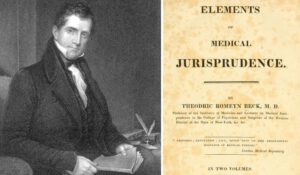 The American physician Theodric Romeyn Beck writes the first significant American book on forensic medicine. It covers topics such as poisons of all kinds, dealing with the situation of persons found dead, and wounds on the living body. The book is invaluable for writers of detective novels set in the period!
The American physician Theodric Romeyn Beck writes the first significant American book on forensic medicine. It covers topics such as poisons of all kinds, dealing with the situation of persons found dead, and wounds on the living body. The book is invaluable for writers of detective novels set in the period!
Read volume 2 online here: https://archive.org/details/elementsofmedica02beck/page/n10/mode/1up?ref=ol&view=theater
Dream of the Amazon
Travels in Brazil, in the years 1817-1820. Undertaken by command of His Majesty the King of Bavaria by Johann Baptist von Spix and Karl Friedrich Philipp von Martius
Carl Friedrich Phillipp Von Martius and Johann Baptist von Spix were naturalists who collected and sketched their way through Brazil and Peru. Travelling over 2,250 km throughout the Amazon Basin from 1817 to 1820, they were charmed by the people, customs and the cultural diversity they encountered.
The two young men brought back a large variety of specimens of plants, animals and ethnographic artifacts. These constitute an important basis for today’s National Zoological Collection and also the Museum of Ethnography in Munich.
Read the travel adventure online here: https://archive.org/details/travelsinbrazili00spix/page/n9/mode/2up
Become an expert on palm-trees
Historia naturalis palmarum: opus tripartitum by Carl Friedrich Phillipp Von Martius
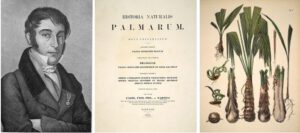 If you are about to arm-chair-travel to the Amazon, don’t miss the above mentioned Martius’s Historia naturalis palmarum: opus tripartitum. The Amazon Basin is the most species-rich palm region in the world, and based on his travels, Martius outlines the modern classification of palms and prepared the first maps of palm bio-geography.
If you are about to arm-chair-travel to the Amazon, don’t miss the above mentioned Martius’s Historia naturalis palmarum: opus tripartitum. The Amazon Basin is the most species-rich palm region in the world, and based on his travels, Martius outlines the modern classification of palms and prepared the first maps of palm bio-geography.
Praise by Alexander von Humbold for the author and his work: “For as long as palms are named and known, the name of Martius will be famous.“
Read it online here: https://www.biodiversitylibrary.org/bibliography/506
Get a glimpse into Bedlam
Sketches in Bedlam; or Characteristic traits of insanity, as displayed in the cases of one hundred and forty patients of both sexes, now, or recently, confined in New Bethlem, by Constant Observer; 182
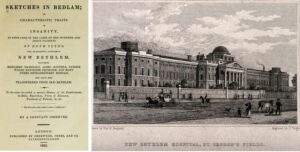 An anonymous author allows you glimpses into the world of so-called insanity. The ‘Constant Observer’ provides cases of 140 patients that lived in the Bethlem Royal Hospital, a psychiatric hospital commonly known as Bedlam. While glossing over the problems of the housing conditions, the book focuses on case studies (or rather moralistic tales). These ‘sketches’ include a patient who tried to assassin King George III, his accomplice, and a sailor who participated in the mutiny aboard the HMS Hermione (1797), the bloodiest in British naval history.
An anonymous author allows you glimpses into the world of so-called insanity. The ‘Constant Observer’ provides cases of 140 patients that lived in the Bethlem Royal Hospital, a psychiatric hospital commonly known as Bedlam. While glossing over the problems of the housing conditions, the book focuses on case studies (or rather moralistic tales). These ‘sketches’ include a patient who tried to assassin King George III, his accomplice, and a sailor who participated in the mutiny aboard the HMS Hermione (1797), the bloodiest in British naval history.
Read it online here: https://publicdomainreview.org/collection/sketches-in-bedlam-1823
Discover geognosy
A geognostical essay on the superposition of rocks, in both hemispheres by Alexander von Humboldt
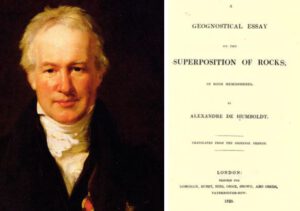 Geognosy was a branch of geology dealing with the materials of the earth and its general exterior and interior constitution. The term was invented in 1780. Based on his own research in South America, Alexander von Humboldt, the leading naturalist and explorer of the age, explains all you ever need to know about the development of mountains.
Geognosy was a branch of geology dealing with the materials of the earth and its general exterior and interior constitution. The term was invented in 1780. Based on his own research in South America, Alexander von Humboldt, the leading naturalist and explorer of the age, explains all you ever need to know about the development of mountains.
Read it online here: https://archive.org/details/geognosticalessa00humbrich/page/n7/mode/2up
Go on a secret mission
Memoirs Of The Baron De Kolli: Relative To His Secret Mission In 1810, For Liberating Ferdinand Vii, King Of Spain, From Captivity At Valencay by Louis Collignon, Baron de Kolli
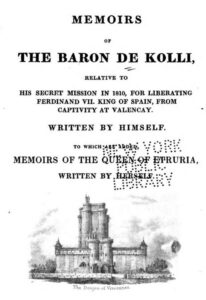 In 1810, a minor French Baron in the service of the British Government set out to rescue Ferdinand VII, King of Spain, from his captivity in the French Chateau Valençay. His memoirs, published in 1823, are an involuntarily comical tale of failure. British critics find little literary value in the story and are dismayed by the frank memories: For their taste, Baron de Kolli tells too freely about his mistakes and the end of the mission in a French prison before he even reached the Spanish King in Valençay.
In 1810, a minor French Baron in the service of the British Government set out to rescue Ferdinand VII, King of Spain, from his captivity in the French Chateau Valençay. His memoirs, published in 1823, are an involuntarily comical tale of failure. British critics find little literary value in the story and are dismayed by the frank memories: For their taste, Baron de Kolli tells too freely about his mistakes and the end of the mission in a French prison before he even reached the Spanish King in Valençay.
Read it online here: https://www.google.de/books/edition/Memoirs_of_the_Baron_de_Kolli/V0ILAAAAYAAJ?hl=de&gbpv=1&dq=Memoirs+Of+The+Baron+De+Kolli+Relative+To+His+Secret+Mission+In+1810&printsec=frontcover
Related articles
Article by Anna M. Thane, author of the novel
“Von tadellosem Ruf” (http://amzn.to/2TXvrez)
